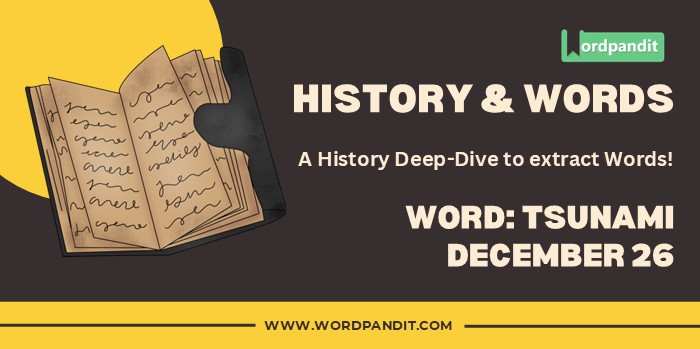History & Words: ‘Tsunami’ (December 26)
Welcome to ‘History & Words.’ 🌟 I’m Prashant, founder of Wordpandit and the Learning Inc. Network. This series combines my passion for language learning with historical context. Each entry explores a word’s significance on a specific date, enhancing vocabulary while deepening understanding of history. Join me in this journey of words through time.
📚 Table of Contents
🔍 Word of the Day: Tsunami
Pronunciation: /tsuːˈnɑːmi/ (tsoo-NAH-mee)
🌍 Introduction
On December 26, 2004, a massive underwater earthquake off the coast of Sumatra, Indonesia, triggered one of the deadliest tsunamis in recorded history. This catastrophic event, known as the Indian Ocean Tsunami, claimed over 230,000 lives across 14 countries and fundamentally changed how the world approaches disaster preparedness.
The word “tsunami” represents one of nature’s most powerful and destructive forces. Unlike regular ocean waves generated by wind, tsunamis are caused by sudden displacements of water, usually from earthquakes, volcanic eruptions, or underwater landslides.
This devastating natural phenomenon has shaped coastal communities’ understanding of oceanic hazards and led to significant advances in early warning systems and international cooperation in disaster response.
🌱 Etymology
The word “tsunami” comes from the Japanese terms “tsu” (津) meaning “harbor” and “nami” (波) meaning “wave.” Japanese fishermen coined the term after noticing that harbors would be devastated by these waves while ships in deeper waters remained largely unaffected.
📖 Key Vocabulary
- 🔑 Seismology: The study of earthquakes and seismic waves
- 🔑 Subduction Zone: Area where tectonic plates collide, often triggering earthquakes
- 🔑 Run-up Height: The maximum vertical height above sea level reached by a tsunami on shore
- 🔑 Inundation: The horizontal distance that a tsunami travels inland from the shoreline
🏛️ Historical Context
Tsunamis have been documented throughout human history, with ancient civilizations recording their observations of these destructive waves. The earliest known written account comes from Ancient Greece, describing a tsunami that struck the coast of Syria in 2000 BCE.
The eruption of Krakatoa in 1883 generated one of the most powerful tsunamis before the modern era, providing scientists with crucial data about the relationship between volcanic activity and tsunami generation.
The development of seismology in the 20th century improved understanding of tsunami formation, leading to the creation of the Pacific Tsunami Warning System in 1949, following a devastating tsunami in Hawaii.
⏳ Timeline
- 1755: Lisbon Earthquake and Tsunami
- 1883: Krakatoa Eruption and Tsunami
- 1946: Alaska Tsunami leads to warning system development
- 1960: Great Chilean Earthquake generates Pacific-wide tsunami
- 2004: Indian Ocean Tsunami (December 26)
- 2011: Tōhoku Earthquake and Tsunami in Japan
- 2018: Palu Tsunami in Indonesia
- 2022: Hunga Tonga eruption triggers Pacific-wide tsunami
🌟 The Day’s Significance
December 26, 2004, began with a massive 9.1 magnitude earthquake off Sumatra’s coast, generating waves that reached heights of up to 30 meters (100 feet) in some areas. The tsunami struck without warning, as no Indian Ocean-wide warning system existed at the time.
This catastrophe led to unprecedented international cooperation in disaster response and recovery efforts. The event highlighted the critical need for early warning systems and public education about tsunami risks.
The aftermath sparked major improvements in global tsunami monitoring and warning capabilities, including the establishment of the Indian Ocean Tsunami Warning System in 2006.
💬 Quote
“The ocean’s power commands respect. The 2004 tsunami taught us that preparation and education are our best defenses against nature’s forces.” – Kofi Annan, former UN Secretary-General
🔮 Modern Usage and Reflection
Today, “tsunami” has entered common usage worldwide, often used metaphorically to describe overwhelming forces or sudden, powerful changes in various contexts.
The term has become associated with disaster preparedness and international cooperation, reflecting humanity’s efforts to better understand and prepare for these natural hazards.
🏛️ Legacy
The 2004 tsunami’s legacy includes vastly improved warning systems, better public education about tsunami risks, and enhanced international cooperation in disaster response.
These advances have saved countless lives, as demonstrated during subsequent tsunamis where early warning systems successfully alerted coastal populations.
🔍 Comparative Analysis
While historical tsunami responses were largely reactive, modern approaches emphasize prevention, preparation, and early warning. This shift reflects broader changes in how society addresses natural disasters.
💡 Did You Know?
🎓 Conclusion
The 2004 Indian Ocean Tsunami stands as a pivotal moment in human history, transforming our understanding of these natural phenomena and catalyzing global efforts to prevent similar tragedies through improved warning systems and international cooperation.
📚 Further Reading
- 📘 “The Indian Ocean Tsunami: The Global Response to a Natural Disaster” by Pradyumna P. Karan
- 📗 “Tsunami: The Underrated Hazard” by Edward Bryant
- 📙 “Wave of Destruction: The Stories of Four Families and History’s Deadliest Tsunami” by Erich Krauss












